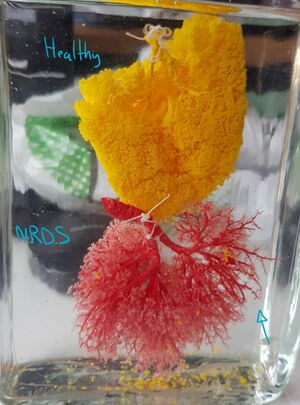56. NRDS
Organ: Lung
Description:
Two different bronchial trees can be seen. The upper one shows many nice alveoli. The preparation looks like an upside-down bush wish many leaves.
The lower one shows way fever alveoli. This preparation looks more like an upside-down tree with no leaves, only branches.
Diagnosis: NRDS
Causes:
- Premature birth, lack of pulmonary surfactant
Theory:
These preparations are made by insertion of some corrosive fluid into the bronchial tree. The fluid will be absorbed into the lung parenchyme and destroy it, leaving only nice-looking models of the bronchial trees.
The upper preparation belongs to a healthy lung. The fluid filled the alveoli quite nicely. No part of the bronchial tree contains measurably fewer alveoli.
The lower preparation belongs to an NRDS-affected lung. In NRDS are most alveoli atelectic (collapsed). When the fluid is inserted into a piece of lung with atelectic alveoli can the fluid not enter these alveoli, which means that they’re not included on this model of the bronchial tree. Very few alveoli are visible, especially where the arrow points, because at this part was the atelectasis more widespread.
